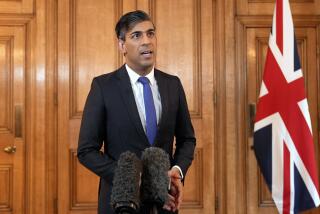Pilots Vow to Keep Up Attack on Iraqi Targets and Psyches
- Share via
EASTERN SAUDI ARABIA — Yes, it’s an air war. But it’s also a war of morale.
The American pilots who are taking the “lightning and thunder” of Desert Storm straight to Saddam Hussein returned Friday from a second day over the skies of Iraq, their morale high and barely contained. Again, they had bloodied one the world’s most bellicose militaries, and the Americans knew that more than the desert sands were shaking under the little sliver of new moon in the Persian Gulf.
U.S. Marine pilots kept up the almost round-the-clock bombing of Iraq’s vaunted Republican Guards, held in reserve in an arc stretching along the northwest of Kuwait. The terrible punishment they delivered included the 500-pound cluster bomb, which rains deadly bomblets over a wide area.
“It’s been a constant, continual bombing with no letup,” said Col. Manfred A. Rietsch, commander of Marine Air Group 11, based at the Marine Corps Air Station in El Toro. “We will destroy tanks, bunkers, go after their vehicles and whatever is of military value. And if we keep hitting them round-the-clock, it’s bound to have a psychological impact.”
The comments from Rietsch, a veteran military pilot who flew more than 600 combat missions in Vietnam, gave the first indication that supersonic F/A-18 fighters from El Toro were heavily involved in the bombing of enemy positions in Iraq and occupied Kuwait. Half of the estimated 48 Hornets in the gulf are from El Toro.
Rietsch, a South Laguna resident, was sent to the Persian Gulf area in August with the initial deployment of the 3rd Marine Aircraft Wing. Before taking over the air group a little more than a year ago, Rietsch, a Top Gun graduate from Miramar Naval Air Station, had commanded a fighter attack squadron.
With more than 6,000 hours of flying time in tactical aircraft, Rietsch, who was born in Gornau, Germany, served as inspector of the 3rd Marine Aircraft Wing prior to taking command of the air group.
With the U.S. and coalition sorties numbering in the thousands and successes overwhelming, pilots--and the tens of thousands of ground troops that cheered them on--could only wonder about the savage toll being taken on the psyche of the enemy to the north. Hardened, that’s how the Iraqis thought of themselves. But are they hard enough for this? And will they be hard enough to take it again tomorrow?
Col. Al Whitley, commander of the U.S. Air Force 37th Tactical Fighter Wing, which flies the F-117A Stealth fighter, was in the first wave of planes to shatter the skies over Baghdad at the opening of the war. Among the explosions and trails of missiles and antiaircraft tracers, Whitley looked out of his cockpit and saw . . . highway traffic.
“I have never seen so many people leave a city,” he said. “It was bumper to bumper leaving the city. I don’t think they were going to the Saddam rally that night.”
This story was compiled in part from Pentagon combat pool reports reviewed by military censors.
More to Read
Sign up for Essential California
The most important California stories and recommendations in your inbox every morning.
You may occasionally receive promotional content from the Los Angeles Times.










